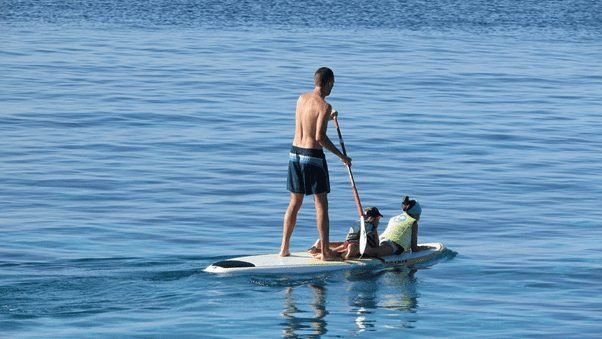Last Updated on April 4, 2022 by admin
If you are new to stand up paddle boarding, it is important to know the basic moves before hitting the water. Here are a few of the most common moves:
- The Paddle Out:
This move is used to get started on your board. Place your paddle in the water and use it to push yourself away from the shoreline.
- The Forward Stroke:
To execute this move, place the paddle blade in the water near your feet and push forward, extending your arms fully. Make sure to keep your back straight and bend your knees slightly for added power.
- The Reverse Stroke:
This move is just like the forward stroke, but will be pushing the paddle blade away from you instead of towards you.
- The Sidestroke:
This move is used to turn the board, and can also be used for speed control. To execute, place the paddle blade in the water on the side of the board that you want to turn towards. Then, use your arms to pull the paddle through the water in a sweeping motion.
- The Sprinter’s Start:
To get started quickly, use this move. Paddle out until you are even with the front of your board, then plant your paddle in the water and step onto the board. Use your arms and legs to push off from the paddle and start paddling.
- The Stop:
This move is used to stop the board quickly. To execute, place the paddle in the water parallel to the board and use it as a brake.
- The Turn:
This move is used to turn the board in the opposite direction of your sidestroke. To execute, paddle on the side of the board that you want to turn towards, then use your arms to pull the paddle through the water in a sweeping motion.
- The 180-Degree Turn:
This move is used to quickly turn the board around. To execute, paddle on the side of the board that you want to turn towards, then use your arms to pull the paddle through the water in a clockwise motion.
- The 360-Degree Turn:
This move is used to quickly turn the board around. To execute, paddle on the side of the board that you want to turn towards, then use your arms to pull the paddle through the water in a clockwise motion.
Hold your paddle above your head with both hands, and pass it over the top of your head – bringing it down on the other side.
- The Sculling:
This move is best used to turn or slow down while paddling. To do this move, place the paddle blade in the water about 20 inches from where you sit and hold it near your hip, using only one hand to hold the shaft of the paddle (This will take practice). Then, slide that hand up and down along its length for added control.
- The J-Stroke:
This move is best used to maneuver around an object when the current is too strong to fight. To execute this move, place the paddle near your feet and use it to “sweep” the board into a turn.

- The Forward Sweep:
This move can be used for speed control or moving forward after stopping using the sculling maneuver (see #10). To perform this move, place the paddle blade in the water about 20 inches from where you sit and hold it near your hip with both hands, then simply slide them along its length towards you for added power.
- The Windmill:
This move is best used when paddling through choppy waves or windy conditions so you don’t lose balance on your board. To do this move, keep your knees bent and lean forward slightly. Then, swing your paddle in a wide arc over the water to the other side of the board so that it lands in front of you. Keep moving until you are standing upright again – leaning back!
- The J-Stroke/Sculling Combination:
This move is best used when maneuvering around an object when the current is too strong to fight. To execute this move, place the paddle near your feet and use it to “sweep” your board into a turn while simultaneously sculling yourself away from the direction you want to go in (see #10).
- The Tack:
While SUP boarding, this move can be used to change direction against or with the wind or waves. It is best used when you have plenty of open water space in which to make the turn. To execute, paddle perpendicular to the board (90 degrees) and then turn the board using the wind or waves by paddling in the new desired direction.
- The Pivot:
This move can be used to quickly change direction in a tight spot – like when you’re SUP boarding in a creek or river. To do this move, paddle on one side of the board until you’re facing the opposite way, then use your paddle blade as a pivot point to twist the board around until you’re facing the original direction again.
- The Hip Snap:
This move is best used for getting up onto your SUP board from the water. To do this move, simply twist your hips to one side and use your paddle to pull yourself up onto the board while using the other hand for balance.
- The Sculling/J-Stroke Combination:
This move is best used when paddling in windy conditions so you don’t lose balance on your board. To execute this move, place the paddle near your feet and use it to “sweep” the board into a turn while simultaneously sculling yourself away from the direction you want to go in (see #10).
- The Layback:
This move is best used when catching smaller waves or gliding over flat water conditions – it requires less effort than paddling alone. To do this move, simply lay back with the paddle behind your head and scull through the water.
- The Forward Sweep/Waves Combination:
This move best used when maneuvering around an object when the current is too strong to fight. To execute this move, place the paddle near your feet and use it to “sweep” yourself into a turn while simultaneously using waves or wind to help push you along in that direction.

Conclusion:
No matter if you’re a beginner or an advanced stand-up paddle boarder, there are plenty of moves to choose from. If you need help choosing the best SUP for your needs, take a look at our blog post on how to pick out the best inflatable paddle boards that will be perfect for beginners and more experienced paddlers alike! If you’re looking for the best 2 person paddle board, you must check this out!






















